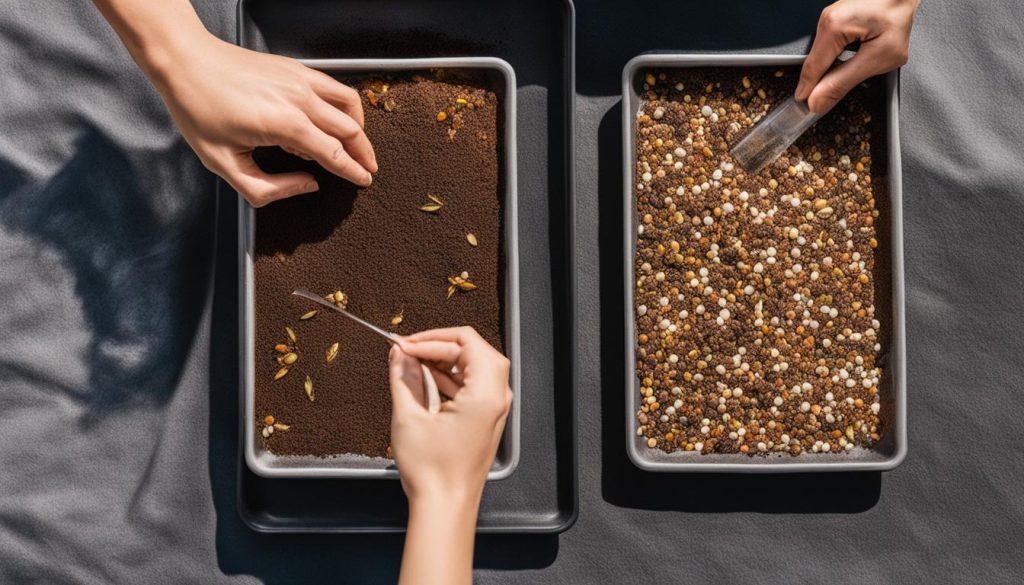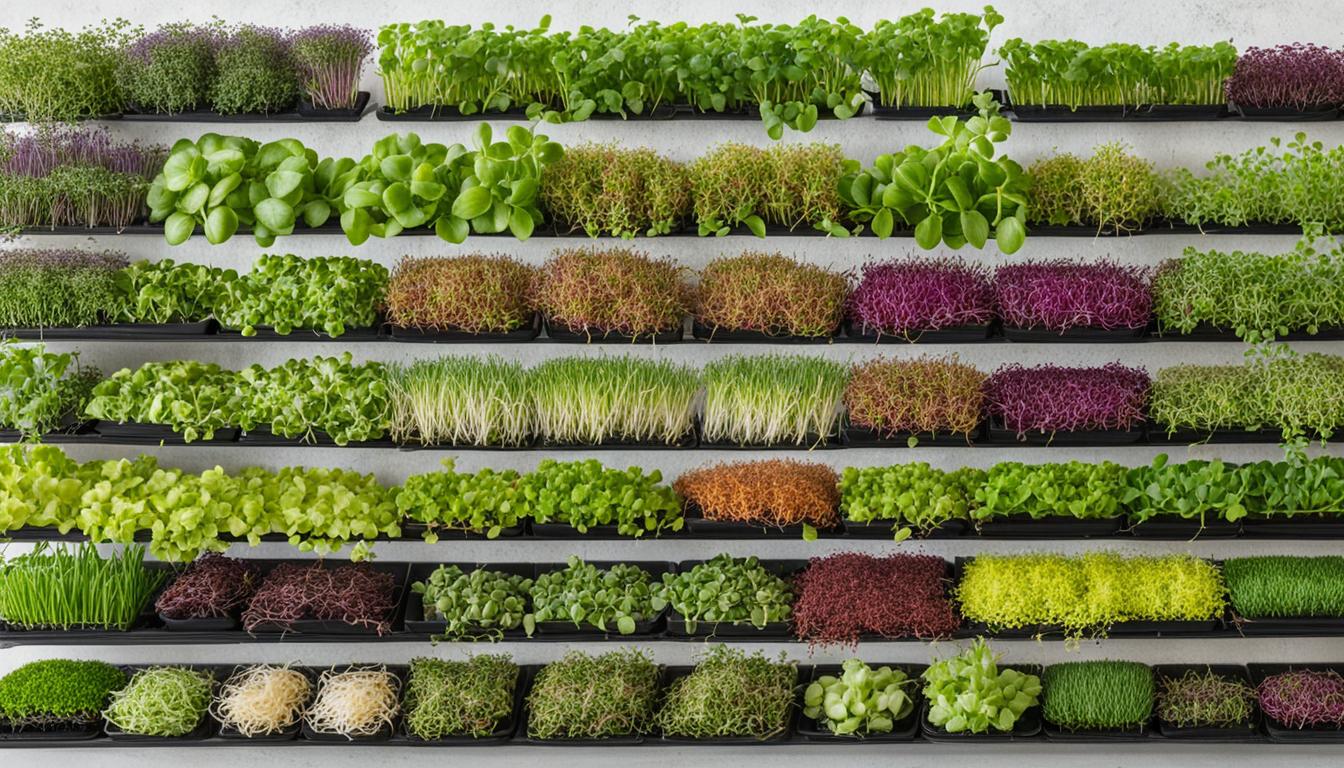As health trends pivot towards nutrient-dense foods, the debate of microgreens vs sprouts surfaces with an emphasis on their distinct health benefits. These petite plants are not just a culinary fad; they pack a punch in the nutritional arena, teeming with essential vitamins and minerals. Exploring the nuances that define the difference between microgreens and sprouts gives insight into the potency of their respective virtues for our well-being. From the dense phytochemical profiles of microgreens to the enzyme-rich character of sprouts, understanding the microgreens health benefits alongside the sprouts health benefits unravels the layers of their salubrious appeal. Rendered as more than just garnish, these tiny greens have become titans in the realm of health foods, garnering attention from health enthusiasts and culinary experts alike.
Key Takeaways
- Microgreens and sprouts both deliver a high quotient of nutrients, yet differ in growth stages and nutrient concentrations.
- Microgreens are celebrated for their higher levels of carotenoids and chlorophylls, enhancing their anti-diabetic and anti-carcinogenic potential.
- Sprouts are rich in amino acids and enzymes, promoting good digestion and overall vitality.
- Understanding the microgreens health benefits allows for informed decisions when incorporating these greens into a diet.
- The choice between microgreens vs sprouts can be guided by individual health goals and culinary preferences.
- Despite their differences, both microgreens and sprouts are versatile additions to a health-conscious diet.
Exploring the Basics: What are Microgreens and Sprouts?
Understanding the foundational elements of these nutrient powerhouses begins with deciphering what makes microgreens and sprouts such unique additions to our diets. Both boast a host of microgreens benefits and sprouts benefits that make them not just a culinary trend, but a health revolution in miniature form.
Defining Microgreens and Their Early Harvest
Microgreens are the tender, young shoots of vegetables and herbs, plucked from the soil at the zenith of their nutrient concentration. Typically harvested between 7 to 21 days after germination, they are celebrated for their intense flavors and robust microgreens nutrition profile. Enthusiasts of homegrown nutrition are discovering the simplicity behind how to grow microgreens, embracing the joy of cultivating their vitamin and mineral-rich gardens, no matter the size of their living space.
The Lifecycle and Characteristics of Sprouts
Sprouts are yet another potent source of vitality, germinating from seeds into tiny but mighty plants in a mere 3 to 5 days. They may lack the foliage of microgreens, but what sprouts lose in leaves, they make up for with a rapid turnaround and versatile uses. The ease of how to grow sprouts, requiring no soil and minimal space, makes them a favorite among urban dwellers seeking sprouts nutrition without the need for a green thumb.
Whether you savor the crisp texture of sprouts in a fresh salad or enjoy the concentrated flavor of microgreens atop your favorite dish, understanding these greens’ lifecycles and characteristics is essential for harnessing their culinary and nutritional potential.
Nutritional Showdown: Microgreens vs Sprouts
When we talk about nutrition-dense foods, microgreens and sprouts are often mentioned as superfoods due to their compact and elevated **microgreens nutrition** and **sprouts nutrition** profiles. While they are both young plants, the concentration of vitamins and minerals they offer is impressive, contributing to myriad **microgreens health benefits** and **sprouts health benefits** that appeal to today’s health-conscious consumers.
Take microgreens, for instance; they are miniature powerhouses of nutrients, packing a richer punch in vitamins and minerals per gram when compared to their fully-grown plant counterparts. This is partly due to the fact that these young plants are harvested just after the first leaves have developed, a stage when the plant’s nutrient density is at its peak. From essential vitamins like C, E, and K to critical minerals like iron, magnesium, and zinc, the **microgreens nutrition** aspect is truly remarkable.
On the flip side, sprouts may be viewed as the underdog when compared to the nutrient content of microgreens, but they hold their weight in the nutrition arena. Sprouts are known for their significant levels of B vitamins, vitamin C, and essential amino acids, which come from a germination process that increases the availability of some nutrients while also introducing enzymes that help with digestion. Even though they are relatively lower in some nutrient contents than microgreens, the **sprouts health benefits** they provide cannot be underestimated, particularly as they add essential nutrients to diets where fruit and vegetable intake may be lacking.
What’s genuinely impressive about both microgreens and sprouts is their potential to support the fight against chronic diseases, due to their high phytochemical content and nutritional density. Their ease of incorporation into a variety of dishes also makes them a convenient choice for enhancing overall diet quality, making them staples for anyone dedicated to maintaining a nutrient-rich diet.
Key Health Benefits of Consuming Microgreens
Delving into the world of microgreens uncovers a treasure trove of microgreens benefits that enhance daily nutrition and overall well-being. These tiny but mighty greens deliver a powerful punch of vitamins, minerals, and antioxidants that support a healthy lifestyle. With their growing popularity, many enthusiasts are also exploring how to grow microgreens at home to capture their peak freshness and optimize their nutritional profile.
Antioxidant Richness in Varied Microgreens
One of the most compelling microgreens health benefits is their exceptional antioxidant content. These antioxidants play a critical role in protecting our cells from damage caused by free radicals, which could lead to chronic diseases if unchecked. The type of microgreen plays a significant part in the level of antioxidants present. For instance, red cabbage microgreens are renowned for their high levels of vitamin C and sulforaphane, which boast strong antioxidant properties.
Vital Vitamins and Minerals in Your Microgreen Selection
When it comes to microgreens nutrition, it’s not just about combatting oxidative stress; it’s also about nourishing the body with essential vitamins and minerals. These greens are an excellent source of vitamin C, E, and K, as well as carotenoids which are vital for eye health and immune function. Furthermore, microgreens such as pea and sunflower are replete with iron and potassium, which help maintain strong, healthy bodies. The inclusion of microgreens in one’s diet can thus aid in managing common health concerns, such as diabetes and obesity, thanks to their nutrient density and low calorie content.
Understanding the Nutritional Value of Sprouts
Often hailed as a powerhouse of health, sprouts are a dynamic food that packs a nutritious punch in a tiny package. Sprouting seeds unlocks a wealth of nutrients making them readily available and easier to digest. Beyond enhancing flavors, sprouts nutrition contributes significantly to a balanced and health-conscious diet. Let’s delve into the substantial benefits sprouts provide and how to grow sprouts to harness their optimal nutritional potential.
How Sprouts Enhance Your Diet with Amino Acids and Pectins
Sprouts are not just a culinary delight; they’re a testament to nature’s wonder, transforming a dormant seed into a burst of vitality. As a prime source of amino acids, they fuel our body with the essential proteins necessary for repair and growth. Pectins found in sprouts also play a pivotal role in our diet. These soluble fibers help maintain good digestive health, lowering blood cholesterol levels and managing blood sugar. Sprouts, therefore, are not just a component of a meal; they’re a strategic addition, enhancing the nutritional density of your plates.
The Role of Antioxidant Capacity in Sprouts
Recognizing the sprouts health benefits is incomplete without a nod to their antioxidant capabilities. The high levels of polyphenols and L-ascorbic acid (vitamin C) in sprouts help the body stave off oxidative stress and its related ailments. Their antioxidant powerhouses enrich our wellness practices, making sprouts a strong ally in our quest for health. For those looking to add a nutritious boost to their day or a natural defense against environmental stressors, incorporating sprouts into the daily diet can be a smart and delicious choice.
Microgreens vs Sprouts: Comparative Analysis of Phytochemicals
Understanding the difference between microgreens and sprouts is pivotal when considering their unique contributions to our diet. Engaging in a comparative analysis reveals a diverse landscape of nutritional components that vary substantially in their potential health impacts. Microgreens nutrition stands out due to the notably high levels of carotenoids and chlorophylls, substances intrinsically linked to a myriad of health benefits. These powerhouse phytochemicals play an instrumental role in powerful anti-diabetic and anti-cholinergic activities, which aids in stabilizing blood sugar levels and improving cognitive functions.
On the flip side, sprouts nutrition introduces a different assortment of nutritional advantages. Rich in amino acids, pectins, and sugars, sprouts are adept in providing an effective antioxidant capacity that contributes to the body’s ability to combat oxidative stress—a precursor to numerous chronic health conditions. The sprouting process itself instigates the elevation of these components, enhancing the sprout’s ability to fend off free radicals and support overall health. When weighing microgreens vs sprouts or considering sprouts vs microgreens, it’s apparent that both enter the dietary arena with distinctive profiles, responding to varied nutritional strategies and preferences.
What’s fascinating is that the phytochemical composition will also change based on external factors such as the species chosen, environmental conditions such as light and temperature, and even the growth stages at which they are harvested. Recognizing these variances is crucial for those looking to tailor their diets more closely with their health objectives, whether they’re eyeing the vitamin C rich environment of microgreens or the enzyme-laden landscape of sprouts.
Whether you opt for the lush greens of microgreens or the tender shoots of sprouts, knowing their strengths allows you to make informed choices regarding your health and culinary delights. As functional foods, they provide not just sustenance, but a platform for increased well-being and preventative health care. The analysis of microgreens vs sprouts isn’t just a matter of comparison—it’s a revelation of the abundant nutrition that nature provides in even the smallest packages.
Growth and Harvest: How Microgreens and Sprouts are Cultivated
Embarking on the journey of cultivating greens at home can be both rewarding and nourishing. Whether you’re exploring how to grow microgreens or diving into the process of cultivating sprouts, understanding the key differences in their growth can enhance your gardening success. Enthusiasts looking to compare microgreens vs sprouts will find that while both can be grown indoors with relative ease, their requirements for soil, light, and water distinguish one from the other.
Differentiated Growth Mediums for Both Greens
For the aspiring urban farmer, microgreens present an attractive option with their versatility in growth mediums. Suitable for those without the luxury of garden space, microgreens thrive in a variety of substrates from traditional soil to modern hydroponic mats and coconut coir. These mediums offer a fertile ground for the seeds to develop into lush, nutrient-rich greens. On the contrary, when learning how to grow sprouts, one quickly discovers the simplicity of their water-based environment. Sprouts forgo the need for soil entirely, growing in water alone, making their cultivation process distinct from their leafier counterparts.
Optimal Conditions for Harvesting Healthy Microgreens and Sprouts
While microgreens require an adequate amount of light to photosynthesize and develop their characteristic colors and tastes, sprouts grow quite contentedly in the dark. The light ensures that microgreens can synthesize the essential nutrients and pigments that define their robust profiles. Conversely, the priority for sprouts lies in hygiene, necessitating frequent rinsing to ensure a clean, bacterial-free growth. This step is essential as sprouts are typically consumed raw and untouched by heat, which would otherwise serve to kill any present pathogens. Both greens offer a diverse array of benefits, from their taste to their nutritional value, making the sprouts vs microgreens debate a matter of personal preference and lifestyle needs.

Culinary Uses: Integrating Microgreens and Sprouts into Your Diet
As health trends continue to emphasize the importance of plant-based nutrients, the spotlight often shines on the microgreens benefits and sprouts benefits that these two superfoods bring to the table. Both are powerhouses of nutrition and have found their way into the hearts and kitchens of food lovers looking to combine good health with great taste. Understanding the difference between microgreens and sprouts is key to utilizing their unique flavors and textures to enhance your culinary experience.
The Flavor Profiles and Textural Enhancements of Microgreens
Microgreens pack a punch in terms of flavor despite their delicate appearance. They come in an array of tastes ranging from the intense spiciness of radish microgreens to the slight sweetness of pea shoots. The inclusion of microgreens in a dish doesn’t just improve nutritional value; they also add a layer of texture that can turn a simple meal into a sophisticated gastronomic delight. Chefs often favor microgreens for their ability to sprouts vs microgreens provide a visually stunning garnish that doesn’t compromise the flavor of the dish. Their crunch and color can elevate even the most basic recipes.
Incorporating Sprouts for a Nutritious Crunch in Meals
When it comes to microgreens vs sprouts, sprouts tend to be subtler in flavor but significant in their nutritional crunchiness. They are incredibly versatile and can be sprinkled over salads for an added health boost, layered into sandwiches for extra texture, or even blended into smoothies for those seeking a nutritional powerhouse drink. The crunchiness of sprouts contrasts perfectly with the softer textures of other vegetables, providing a balance that is as pleasing to the palate as it is to the body.
The creativity in using microgreens and sprouts in the kitchen is boundless, particularly when acknowledging their respective health benefits. Whether you opt for the tender bite of microgreens or the crispy freshness of sprouts, you’ll be enriching your meals with vitamins, minerals, and vital enzymes that contribute to a balanced diet.
Microgreens Health Benefits: Investigating Anti-Diabetic and Anti-Obesity Effects
Delving deeper into the microgreens health benefits, we uncover compelling evidence of their role in combating serious health issues such as diabetes and obesity. Rich in essential nutrients, microgreens are not only a powerhouse of microgreens nutrition, they also offer therapeutic properties that can revolutionize health management practices for individuals worldwide. Studies highlight that these miniature greens, usually harvested just after the cotyledons have developed, pack a dense concentration of bioactive compounds, including carotenoids and polyphenols, known for their anti-diabetic and anti-obesity qualities.
As a staple in the repertoire of health-conscious gourmets, microgreens have the prowess to significantly influence blood sugar regulation, thereby offering an edge in the management of diabetes. Their high antioxidant levels play a pivotal role in stabilizing blood sugar and improve insulin sensitivity, making them a valuable addition to diabetic meal plans. The role of microgreens extends to combating the epidemic of obesity with their low-calorie profile and nutrient density, promoting a feeling of fullness and reducing the inclination towards overeating.
Enthusiasts of a wholesome diet can rejoice in the multifaceted microgreens benefits that stretch beyond basic nutrition. The inclusion of microgreens into the diet is an act of investing in long-term health and wellness. Their subtle yet profound impact on metabolic health paints a bright picture for future dietary recommendations and emphasizes the importance of incorporating these small but mighty greens into daily meal plans.
Ultimately, the concentration of vitamins, minerals, and potent antioxidants makes microgreens a game-changer in the realm of functional foods. By adopting these greens into your eating habits, you are making a conscious choice in favor of your health, equipping your body with the necessary tools to fend off modern-age ailments such as diabetes and obesity. The journey towards better health can very well begin with a tiny seedling on your plate.
Comparing the Food Safety Concerns of Microgreens and Sprouts
When it comes to the healthful additions of microgreens and sprouts to our diets, understanding the considerations of food safety is crucial. These nutritious greens not only offer sprouts benefits and microgreens health benefits but also pose distinct challenges during cultivation that can affect their safety profiles.
Assessing Risks: Sprouts and the Potential for Foodborne Illnesses
Due to the warm, moist conditions required to grow sprouts, there is a heightened potential for the development of foodborne pathogens. These conditions can be a breeding ground for bacteria such as E. coli, Salmonella, and Listeria. The risks, while present, can be managed through careful, consistent rinsing and handling practices, ensuring that the sprouts are safe for consumption. Despite the risks, these greens continue to be sought after for their crisp texture and significant health contributions.
Microgreens: A Safer Alternative in Greens Consumption?
On the converse side of the microgreens vs sprouts discussion, microgreens are generally cultivated in conditions that are less conducive to bacterial growth, thus mitigating some of the food safety concerns associated with sprouts. They are often grown in soil or hydroponic systems that don’t require the same levels of humidity, translating to a diminished risk of contamination. While no agricultural practice is completely without risk, microgreens are widely recognized as a safer alternative to their sprout counterparts, without compromising on their concentrated nutritional benefits.
How to Grow Microgreens at Home for Peak Freshness and Nutrition
Gaining mastery of how to grow microgreens is not merely a gardening pursuit; it’s an invigorating step toward embracing the full spectrum of microgreens nutrition. Unlike the more delicate process for cultivating sprouts, microgreens require a bit of soil and some tender care to unleash their potent health potential. By nurturing these miniature plants on your windowsill or kitchen counter, you will cultivate a consistent source of fresh garnishes brimming with vitality and flavor. The microgreens benefits extend far beyond their fresh taste—they pack a nutritional punch that outshines even their close relatives, the sprouts.
With a plethora of varieties to select from, you can customize your garden to your nutritional desires and culinary needs. Let’s explore the guidelines for choosing the best seeds and the ongoing care that ensures a bountiful harvest. These tips will serve as your compass in the fulfilling journey of microgreen gardening, guaranteeing you reap the myriad of benefits these tiny greens have to offer.
Selecting the Best Seeds and Proper Techniques
Start your microgreen journey by sourcing high-quality seeds, earmarking those known for their resilience and nutritional value. A mix of leafy greens, such as kale and arugula, alongside herbs like basil and cilantro, could provide a dynamic array of flavors and vitamins. The proper technique is simple yet precise: sow your selected seeds in a shallow tray filled with a fine layer of soil or a soil substitute, ensuring even coverage for uniform growth. Adequate lighting, either from a sunny windowsill or a supplemental grow light, will coax the seeds from their slumber, aiding the emergence of vibrant green shoots.
Maintenance and Care for Thriving Homegrown Microgreens
Caring for your burgeoning microgreens involves a gentle touch. Watering should be consistent but measured—overly damp conditions are as detrimental as drought. Use a spray bottle to mist the soil, keeping it moist but not soggy, to prevent mold and over-watering issues. Air circulation is another key component of the care regimen. Position your microgreens in an area where fresh air can circulate freely, but shield them from strong drafts that could dehydrate the tender plants. Adhering to these stipulations fosters an environment where your microgreens can flourish, offering you a constant supply of these nutritional powerhouses with minimal fuss or space.
As you savor the convenience and delight of snipping fresh microgreens from your homegrown supply, you’ll appreciate the inherent simplicity of bringing such nutritional dynamism to your plate. This is how the small act of growing microgreens at home transcends gardening—it becomes an essential and fulfilling component of a health-focused lifestyle, distinguished from microgreens vs sprouts discussions, with its unique charm and benefits.
How to Grow Sprouts Safely and Efficiently in Your Kitchen
Embarking on the journey of how to grow sprouts at home starts by choosing superior quality seeds that are specifically meant for sprouting. This critical choice ensures that the sprouts are not only nutritious but also safe for consumption. Once you’ve sourced your seeds, the next step is selecting the right vessel for sprouting—many find that a regular mason jar topped with a piece of cheesecloth or a fine mesh secured with a rubber band serves perfectly.
Creating a suitable environment for these little gems to flourish is paramount in unlocking their full potential. For optimal sprout growth, a spot in your kitchen that offers consistent ambient temperature without direct sunlight is ideal. This helps in maintaining the moisture levels they need without the heat that could promote unwanted bacterial growth, thus emphasizing the importance of food safety.
One of the most vital steps in growing sprouts safely is the rinsing process. Vigilant and regular rinsing, at least twice daily, is necessary to maintain the cleanliness of the sprouts and prevent any bacterial breeding ground. After rinsing, draining them thoroughly will help keep the sprouts aerated, which is crucial for their health and safety. By diligently following these safety protocols, you can yield a crop of sprouts with remarkable nutrition and health benefits, ready to add a fresh crunch to your dishes.
After a couple of days, you will witness the magic of nature as the sprouts begin to burgeon. They will soon be prepared for harvesting and integrating into your meals, providing a freshness that can only be achieved from homegrown produce. The sprouts benefits extend beyond their lively taste and texture—they’re packed with enzymes, vitamins, and minerals, transforming salads, sandwiches, and even smoothies into nutrient-dense treats that support your well-being.
In short, growing sprouts at home is not only easy and economical; it’s a direct investment in your health. With minimal equipment and some care, you can turn your kitchen into a sprout haven that is both safe and bountiful. Let the venture of growing sprouts become your delightful contribution to a healthy lifestyle.
Conclusion
As we explore the intersection of nutrition and nature, it becomes evident that both microgreens and sprouts are more than mere culinary trends. They embody the synergy of flavor and vitality, bringing forth not just a burst of freshness to our plates but also a plethora of health benefits. The discussion on microgreens vs sprouts is not about which is superior, but rather how each contributes uniquely to a balanced diet.
Embracing Variety: Incorporating Both Microgreens and Sprouts for a Balanced Diet
Diving into the culinary and nutritional aspects of these verdant treasures reveals that microgreens and sprouts complement each other remarkably well. Microgreens, with their concentrated nutrients, become a powerhouse for those looking for an intense influx of vitamins and antioxidants. On the other side, sprouts offer the delightful crunch and essential enzymes, perfect for adding a textural contrast to your meals. Including both in your dietary repertoire bridges the gap between seeking microgreens health benefits and the useful properties sprouts bring to the table.
Final Thoughts: Making the Health-Conscious Choice Between Microgreens and Sprouts
In aligning with wellness goals, whether one leans towards microgreens or sprouts—or elects to combine them—each greenery supports a health-conscious lifestyle. The choice between microgreens and sprouts may hinge upon individual preferences or specific dietary requirements. Regardless, integrating these nutrient-saturated greens can magnify the health benefits of any meal, elevating one’s overall well-being. Ultimately, beyond the distinction of microgreens vs sprouts, a fusion of both in our diets ensures that we are not just eating to live, but living to thrive with vitality and good health as our allies.


